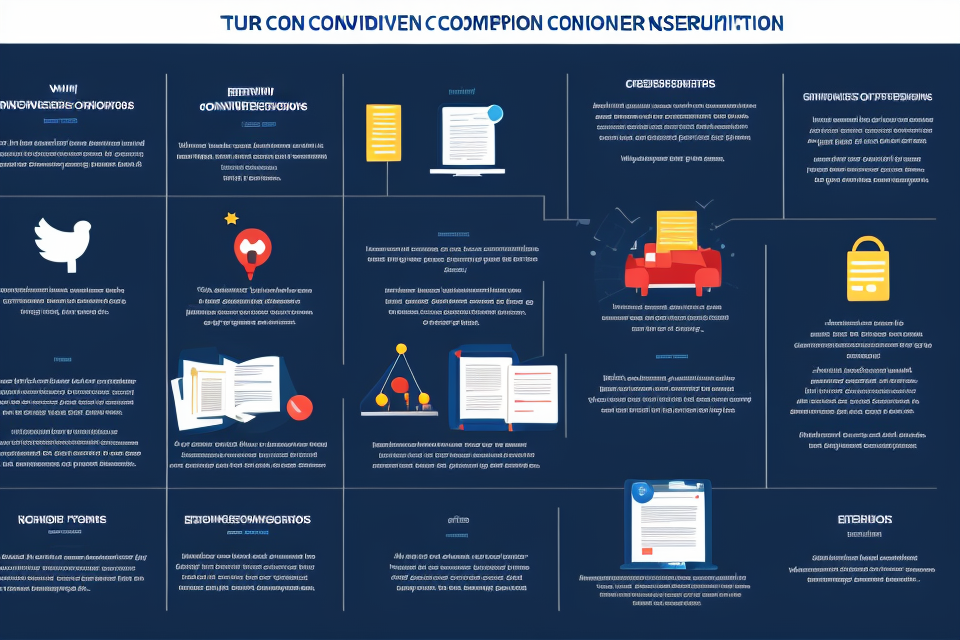Conventions are the unwritten rules and norms that govern our social interactions and behaviors. They are the glue that holds society together, allowing us to communicate and coexist harmoniously. From language to dress codes, there are countless examples of conventions that we encounter every day. Understanding these conventions is crucial for effective communication and navigating social situations with ease. In this article, we will explore some examples of conventions and their importance in our daily lives. So, buckle up and get ready to dive into the fascinating world of conventions!
Definition of Conventions
Explanation of Conventions
In the realm of communication, conventions are the agreed-upon rules and standards that govern the use of language and symbols. They serve as a means of facilitating understanding and efficient communication between individuals and groups. Conventions encompass a wide range of practices, including grammar, syntax, punctuation, spelling, and usage, which together form the basis of effective communication.
Examples of Conventions
Some examples of conventions include:
- The use of the word “e-mail” instead of “email” to indicate the electronic nature of the message.
- The use of “@” symbol to separate the username from the domain name in an email address.
- The use of the serial comma in a list to separate items, such as “red, white, and blue” instead of “red, white and blue.”
- The use of the hyphen to indicate a word’s meaning, such as “co-author” meaning “a person who collaborates with another on a written work.”
- The use of apostrophes to indicate possession, such as “the dog’s toy” instead of “the toy of the dog.”
Overall, conventions play a crucial role in facilitating effective communication by establishing a shared understanding of the meaning and use of language and symbols. By adhering to these established rules and standards, individuals and groups can communicate efficiently and accurately, reducing the potential for misunderstandings and miscommunications.
Types of Conventions
There are various types of conventions that exist in different aspects of our lives. Understanding these conventions is crucial as they shape our interactions and communication with others. The three main types of conventions are social conventions, cultural conventions, and professional conventions.
Social Conventions
Social conventions are the unwritten rules that govern our behavior in social situations. These conventions are often considered to be norms of politeness and etiquette. Examples of social conventions include saying “please” and “thank you,” holding doors open for others, and greeting someone with a smile. Social conventions are important because they help us navigate social interactions and show respect for others.
Cultural Conventions
Cultural conventions are the shared beliefs, customs, and practices of a particular culture or group. These conventions are often passed down from generation to generation and can vary greatly between cultures. Examples of cultural conventions include the way people dress, the foods they eat, and the languages they speak. Understanding cultural conventions is important because it helps us to understand and appreciate different cultures, and to avoid offending others through our own cultural biases.
Professional Conventions
Professional conventions are the unwritten rules that govern behavior in a professional setting. These conventions can vary greatly between different industries and professions. Examples of professional conventions include dress codes, office etiquette, and communication styles. Professional conventions are important because they help to establish a sense of professionalism and maintain a level of respect in the workplace.
Importance of Conventions
Maintaining social order
Social conventions play a crucial role in maintaining social order by establishing a set of rules and norms that guide human behavior in various social situations. These conventions provide a framework for people to interact with each other in a predictable and structured manner, which helps to prevent conflicts and maintain stability in society.
For example, in most cultures, there are specific rules regarding personal space and physical contact. These conventions help individuals understand what is acceptable behavior in different social situations, such as shaking hands, hugging, or maintaining a respectful distance. By adhering to these rules, people can avoid misunderstandings and maintain a sense of order and decorum in their interactions.
Facilitating communication
Conventions also play a critical role in facilitating communication between individuals. By adhering to shared norms and expectations, people can effectively convey their thoughts, intentions, and emotions to others. For instance, in many cultures, eye contact, body language, and facial expressions are used to convey various emotions and intentions.
Furthermore, conventions help individuals understand the context and tone of a conversation, which is essential for effective communication. For example, the use of sarcasm, irony, or humor is often governed by specific conventions that help people recognize and interpret these forms of speech.
Enhancing understanding and respect
Finally, social conventions help to enhance understanding and respect between individuals by establishing shared values and expectations. By adhering to common norms and rules, people can show respect for others and their cultural backgrounds. For example, in many cultures, it is customary to greet others with a specific gesture or phrase, which helps to establish a sense of connection and shared identity.
Moreover, adhering to conventions can help individuals to appreciate the diversity of human experience and perspective. By understanding and respecting the conventions of others, people can gain insight into different cultures and develop a greater appreciation for the richness and complexity of human social interaction.
Examples of Conventions in Everyday Life
Greetings and politeness
In everyday life, we often encounter various conventions that help us navigate social interactions. One such convention is the way we greet each other. In many cultures, a simple handshake or a nod of the head is considered an appropriate greeting. In some cultures, it is customary to bow or to touch the person you are greeting. These conventions help us show respect and acknowledge the presence of others.
Another example of everyday conventions is politeness. We use polite language and gestures to show consideration for others. For instance, we say “please” and “thank you” to indicate that we are making a request or expressing gratitude. We also use polite expressions like “excuse me” or “sorry” to apologize for our actions or to show that we are aware of our surroundings.
Table manners
Table manners are another set of conventions that we encounter in everyday life. These conventions help us show respect for others and for the food we are eating. For example, we use utensils like forks, knives, and spoons to eat our food. We also use napkins to wipe our mouths and hands. In some cultures, it is considered impolite to begin eating until everyone at the table has been served.
Moreover, we use specific table manners when eating with others. We use phrases like “May I please have some more?” or “Excuse me, could you pass the salt?” to make requests. We also use polite expressions like “Thank you for the meal” or “This looks delicious” to show appreciation for the food and the effort put into preparing it.
Dress codes
Dress codes are another set of conventions that we encounter in everyday life. These conventions help us show respect for the occasion and for the people we are meeting. For example, we wear formal attire to a job interview or a wedding to show respect for the occasion and for the people we are meeting.
In some cultures, there are specific dress codes for different occasions. For instance, in some cultures, men wear suits and ties to formal events, while women wear dresses or skirts. In other cultures, people wear traditional clothing to special events or religious ceremonies. These conventions help us show respect for the occasion and for the people we are meeting.
Overall, everyday conventions play an important role in our social interactions. They help us show respect for others, acknowledge their presence, and navigate social situations. By understanding these conventions, we can communicate more effectively and build stronger relationships with others.
Examples of Conventions in the Workplace
In the workplace, there are various conventions that are established to ensure smooth and effective operations. These conventions can range from dress codes to meeting etiquette, and from email communication to workplace culture. Here are some examples of conventions in the workplace:
Business attire
One of the most common conventions in the workplace is the dress code. Most workplaces have established dress codes that employees are expected to follow. The dress code can vary depending on the industry and the company culture. For example, in a professional services firm, employees may be required to wear formal business attire such as suits, dresses, and ties. In a creative agency, the dress code may be more relaxed, allowing employees to express their personal style within certain boundaries.
Meeting etiquette
Another convention in the workplace is meeting etiquette. Meetings are a common feature of most workplaces, and there are certain conventions that are expected to be followed during meetings. For example, arriving on time, taking turns to speak, actively listening to others, and maintaining eye contact are all expected conventions of meeting etiquette. Additionally, certain roles may be assigned during meetings, such as a chairperson or a minute-taker, and these roles come with specific responsibilities and expectations.
Email communication
Email communication is another convention in the workplace. Emails are a primary means of communication in most workplaces, and there are certain conventions that are expected to be followed when sending and receiving emails. For example, using a professional and courteous tone, keeping emails concise and to the point, and responding promptly to emails are all expected conventions of email communication. Additionally, using appropriate subject lines, avoiding unnecessary cc’s and bcc’s, and using proper grammar and punctuation are all important conventions of email communication.
Overall, these are just a few examples of the many conventions that exist in the workplace. By following these conventions, employees can help create a productive and harmonious work environment.
Examples of Conventions in Society and Culture
Conventions play a significant role in shaping the social and cultural aspects of human societies. They can be observed in various forms of expression, from holiday celebrations to traditional ceremonies, and even in artistic and literary conventions. Let’s take a closer look at some examples of conventions in society and culture.
Holiday celebrations
Holiday celebrations are a prime example of how conventions shape our social interactions and cultural practices. From Christmas to Easter, Halloween to Thanksgiving, these holidays have their own set of customs and traditions that are widely recognized and observed by people across different cultures and communities.
For instance, Christmas is typically celebrated by exchanging gifts, decorating trees, singing carols, and attending church services. Easter, on the other hand, involves the celebration of the resurrection of Jesus Christ, with activities such as egg hunting, attending church services, and partaking in family feasts.
These holiday conventions not only bring people together but also help to reinforce cultural values and beliefs, as well as provide a sense of belonging and identity.
Traditional ceremonies
Traditional ceremonies are another form of convention that plays a significant role in shaping societies and cultures. These ceremonies often hold historical, cultural, and religious significance and are passed down from generation to generation.
For example, weddings are a traditional ceremony that holds great importance in many cultures. The rituals and customs surrounding weddings, such as the exchange of vows, the first dance, and the cutting of the cake, are all conventional practices that have been passed down through generations.
Similarly, funerals and other ceremonies for the deceased also have their own set of conventional practices that are observed across different cultures and communities. These ceremonies help to provide a sense of closure and support for the bereaved and play an important role in helping individuals and communities cope with loss.
Artistic and literary conventions
Artistic and literary conventions are another type of convention that shape societies and cultures. These conventions encompass various forms of creative expression, including literature, music, art, and film.
For example, in literature, there are conventional plot structures, such as the three-act structure, which are commonly used to create a sense of narrative coherence and reader engagement. Similarly, in music, there are conventional chord progressions and melodic structures that are used to create a sense of harmony and rhythm.
In art, there are conventional techniques and styles, such as realism and impressionism, that have been developed and refined over time. These conventions help to shape the way artists create and express themselves, as well as influence the way audiences perceive and appreciate art.
Overall, conventions play a vital role in shaping societies and cultures, from holiday celebrations to traditional ceremonies, and even in artistic and literary expressions. By understanding these conventions, we can gain a deeper appreciation for the diversity and richness of human culture and the ways in which it shapes our lives and experiences.
Challenges and Evolution of Conventions
Resistance to change
Conventions, by their very nature, are subject to change over time. As societies evolve and cultures diversify, existing conventions may become outdated or irrelevant. However, people often resist changes to conventions, as they can be seen as a threat to stability and tradition. This resistance can be especially pronounced when the changes are perceived to be unnecessary or inappropriate. For example, a debate over whether to adopt a more inclusive language in a certain context may spark heated arguments and resistance from those who view the current conventions as sacrosanct.
Adapting to diverse cultures
Another challenge faced by conventions is their ability to adapt to the needs of diverse cultures. Conventions are often shaped by the dominant culture of a society, which may not always align with the needs of other cultures. For example, a convention in one culture for written communication may be different from another culture’s convention, and this can lead to misunderstandings or confusion. To address this challenge, some conventions have been modified or replaced over time to better serve the needs of different cultures. For instance, the use of different fonts, such as sans-serif fonts, has become more common in digital communication to improve readability across different languages and cultures.
Influence of technology
Technology has had a profound impact on the evolution of conventions. With the advent of digital communication, new conventions have emerged for how we communicate online. For example, the use of emojis and acronyms has become a common way to express emotions and ideas in digital communication. These new conventions have been shaped by the unique characteristics of digital communication, such as the lack of tone and context in written messages. Additionally, technology has made it easier for people to communicate across borders, leading to a greater need for conventions that can be understood by people from different cultures. As technology continues to evolve, it is likely that conventions will continue to adapt and change to meet the needs of new forms of communication.
FAQs
1. What are conventions?
Answer:
Conventions are unwritten rules or customs that guide social interactions and behaviors in a particular context or culture. They can include everything from common courtesies and etiquette to more formalized codes of conduct. Conventions can vary widely depending on the context, and can be either explicit or implicit. For example, in a business setting, conventions might include dressing appropriately, using formal language, and following established protocols for meetings and presentations. In contrast, social conventions might include things like greeting others with a friendly smile or saying “please” and “thank you” when making requests.
2. Why are conventions important?
Conventions are important because they help us navigate social interactions and understand what is expected of us in different situations. They can also help us communicate effectively and build relationships with others. By following conventions, we demonstrate our respect for others and show that we are aware of social norms and expectations. Additionally, conventions can help us avoid misunderstandings and conflicts, and can contribute to a sense of social cohesion and unity.
3. What are some examples of conventions in different contexts?
In a professional setting, conventions might include things like dressing appropriately, using formal language, and following established protocols for meetings and presentations. In a social setting, conventions might include greeting others with a friendly smile, saying “please” and “thank you” when making requests, and using polite language. In a cultural context, conventions might include things like observing certain holidays or celebrations, following specific customs or traditions, and adhering to certain beliefs or values.
4. Can conventions change over time?
Yes, conventions can change over time. As society evolves and culture shifts, so too do the conventions that guide our interactions and behaviors. For example, what was once considered appropriate or acceptable behavior in a professional setting might no longer be considered appropriate as social norms and expectations change. Additionally, new technologies and innovations can also lead to changes in conventions, as people adapt to new ways of communicating and interacting with one another.
5. How can I learn about conventions in a particular context or culture?
To learn about conventions in a particular context or culture, you can start by observing and paying attention to the behaviors and interactions of others. You can also seek out information from reliable sources, such as books, articles, or online resources that provide guidance on social norms and expectations in a particular context or culture. Additionally, you can ask others for their insights and advice, or seek out guidance from experts or mentors who have experience in the context or culture you are interested in. By taking the time to learn about conventions, you can better navigate social interactions and build stronger relationships with others.









